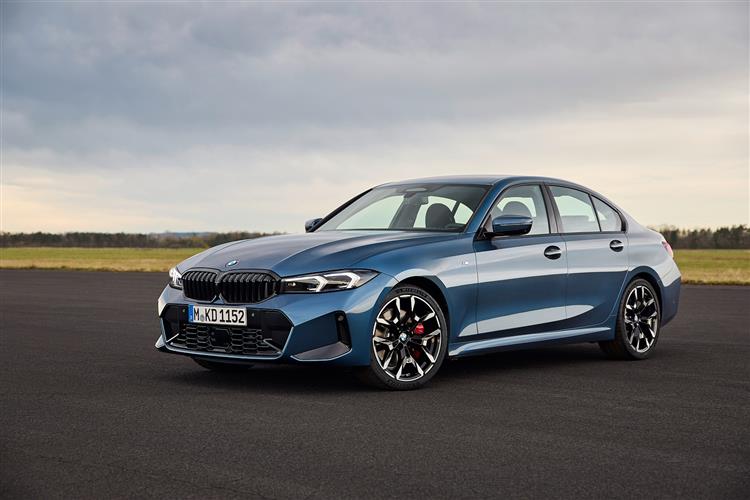BREAKING 3 (some text hidden) --NONE--
By Jonathan Crouch
The seventh generation BMW 3 Series gets more appealing in this enhanced form. Jonathan Crouch takes a look.
Ten Second Reviewword count: 95
The BMW 3 Series has ruled the compact part of the mid-sized executive segment for more than forty years and the company's hopes are high for this further improved version of the 'G20' seventh generation design. It's smarter and gets an even more sophisticated cabin. Diesel's been dropped but the 330e PHEV gets a much bigger battery. And there's a big step forward in media connectivity. All the things you'd expect from a facelift really. Something else you'd expect from this model is rear wheel drive handling purity. It doesn't disappoint in that regard either.
Backgroundword count: 163
The BMW 3 Series has had an unparalleled reputation both for its quality and supreme handling in the premium mid-size segment for more than 40 years. When this the seventh generation 'G20'-series model arrived back in 2018, it raised the bar even higher. But then during Covid, we got an all-new version of this car's arch-rival, the Mercedes C-Class, which prompted a mid-term G20 update. In mid-2024, this segment of the market changed again with the introduction of Audi's A4-replacing new A5. And again, BMW responded with a G20 model update, which is what we look at here. The 3 Series is regarded as the heartbeat of the brand and always has been since the first generation design was launched way back in 1975. Today, this model line accounts for 14% of BMW's global sales, so it could hardly be more important. These updates must sustain the car until it's replaced by an EV next-generation model with the brand's forthcoming 'Neue Klasse' architecture.
Driving Experienceword count: 356
Unlike Audi and Mercedes, BMW doesn't see diesels as part of its electrifed future. it does however, continue to put a lot of store in its PHEV technology, which is why the major changes with this second update to the G20-era design are with the 330e Plug-in Hybrid. This now gets a bigger 19.5kWh battery, which allows for a considerably longer 63 mile electric driving range. That means a suburban driver really could start to use their 330e much like an EV. The combined output of this powertrain's 2.0-litre petrol engine and electric motor now stands at 292hp (8hp more than before), facilitating a 62mph sprint time of 5.9s en route to 146mph. Otherwise, the only remaining mainstream engine you can have is the 184hp 2.0-litre petrol unit of the 320i which, like the 330e, is offered only in rear-driven form and makes 62mph in 7.4s en route to 146mph. If you want something more powerful, there's the M340i xDrive, which has AWD and a 3.0-litre petrol six cylinder unit developing 374hp and, thanks to 500Nm of torque, is good for 62mph in 4.4s on the way to a top speed limited to 155mph. The road-burning M3 Competition still tops the range of course, now with mandatory xDrive and an uprated 530hp version of the usual 3.0-litre twin turbo six cylinder engine. With mainstream models, BMW's tweaked the chassis to imptrove comfort. And has added stiffer mounting points for the rear dampers, faster, more responsive steering and an upgrade for the optional adaptive dampers. Otherwise, much is familiar here. All 3 Series models get the near perfect 50:50 weight distribution that has defined this model line to date: this updated seventh generation model doesn't deviate too far from that script. Still notable are the standard 'lift-related' dampers. These clever shock absorbers incorporate structures that provide extra damping at the extremes of wheel travel, allowing quite a firm sporting set-up to be adopted, but also one able to deliver a fluent ride over tarmac imperfections. Thanks to that, this car's able to combine a set-up for Silverstone with something that works equally well on the North Circular.
To see the full road test text contact us on 0330 0020 227
Pictures (high res disabled)

.jpg)
|
.jpg)
|
.jpg)
| |||
.jpg)
|
.jpg)
|
.jpg)
| |||
.jpg)
|

|
Statistics (subset of data only)
Min |
Max |
|
0-62mph (secs): |
5.8 (330i Saloon 2.0 M Sport Auto) |
7.1 (320d Saloon 2.0 M Sport) |
Braked Tow Weight (kg): |
1600 (320d Saloon 2.0 M Sport) |
|
CO2 (g/km): |
109 (318d Saloon 2.0 SE Auto) |
142 (330d Touring 3.0 xDrive M Sport Auto) |
Cylinders: |
4 (318d Saloon 2.0 M Sport) |
6 (330d Saloon 3.0 M Sport Auto) |
Driven Wheels: |
4 (320d Saloon 2.0 xDrive M Sport Auto) |
|
Emissions: |
6 (318d Saloon 2.0 M Sport) |
|
Engine Power (bhp): |
150 (318d Saloon 2.0 M Sport) |
265 (330d Saloon 3.0 M Sport Auto) |
Engine Power (ps): |
152.09 (318d Saloon 2.0 M Sport) |
268.68 (330d Saloon 3.0 M Sport Auto) |
Engine Size (cc): |
1995 (318d Saloon 2.0 M Sport) |
2993 (330d Saloon 3.0 M Sport Auto) |
... and 19 other stats available | ||
Scoring (subset of scores)
Category: Luxury Saloons and Estates
| Performance | |
| Handling | |
| Comfort | |
| Space | |
| Styling, Build, Value, Equipment, Depreciation, Handling, Insurance and Total scores are available with our full data feed. | |



